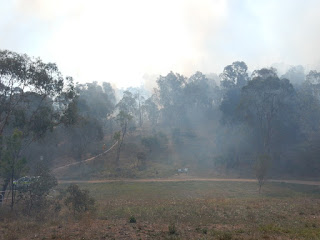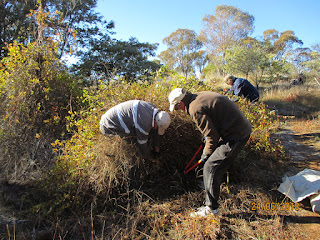The
distraught reports from Mt Rogers' carers of tree felling, branches cut and
ancient eucalypts marked with striped or yellow tape was an inauspicious
beginning to the Hazard Reduction Burn (HRB) of Saturday 21st April. We
hadn’t expected “to be the last to know” because protocols regarding informing
communities improved dramatically after the eastern section of Mt Rogers was
the site of the reserve’s first HRB in August 2011.
Several
weeks later Prescribed Burns signs went up, letter-boxed notices were delivered
to the nearest properties and I received an emailed notification through Rachel
Tokley.
Visible
preparations began on Friday 20th April. Fire Management Unit
personnel installed sprinklers up-track from the Notice Box and all round the
HRB’s borders so the extent of the blaze would be contained. Ancient and
significant trees were hosed down or sprinkled to ensure their damp bark was
able to repel the spread of fire up their trunks.
On
the day, Andrew (Dir. Comm.) confirmed locations with me in order to protect the
Blue Grass lily clumps, our plantings and the prickly Hakeas that serve as
refuges for small birds. It was clear from conversations with the Fire
Management Unit’s Andrew and Tom that our electronic mapping of rarer plants
and Mt Rogers’ sensitive areas, with Ginninderra Catchment Group’s assistance by
contacting the research unit, had been effective.
Clare
Beale had remapped and GPS’ed significant areas on March 7th during
our introductory ‘walk round’ with Rachel Tokley. Whenever I met the actual
fire crews during or after the burn it was clear that they each had in-depth
ecological understanding, knowledge of individual species’ characteristics and
responses to fire. They treated Mt Rogers with respect and care whilst carrying
out their tasks and burning what we have loved for decades.
 View of the burn from Flynn playground.
View of the burn from Flynn playground.
Even
though they may have begun their fire-fighting careers seeing “the bush” as the
enemy the fire-fighters now apply their training to achieve the patchy and cool
burns that give native species the maximum chance of natural and robust
recovery.
There
were at least six units, including Hall’s Volunteer Rural Fire Brigade’s Unit
10, present on 21st. Each crew was allotted a section of the reserve
for specialist lighting and managing the fires with their tankers, equipment
and hoses along and down from the mostly northern boundaries. As it was a calm
day the smoke tended to ascend rather than drift down the slopes towards Flynn.
There were exceptions, with no-one being exempt from being affected by swirling greyness quite
regularly.
 View north from behind Schwarz Pl, Flynn
View north from behind Schwarz Pl, Flynn
Quite
soon after seeing the first smoke from near Schwarz Place, several of us saw a
raptor soaring above the smoke. Neither my attempts to photograph the bird nor
the other observers were able to establish its identity. Black Kites are known to respond
rapidly to seeing smoke, knowing that there will be fleeing animals to be
snatched up in their talons. But Black
Kites aren’t common in this region.
Currawongs
didn’t miss the opportunities of multiple roasted invertebrate ‘dinners’, calling and coming in soon after the areas had cooled. Magpies were more demure
about their foraging. Today, eleven days afterwards there were 15 Crimson
Rosellas amongst the 5-Ways Snow Gums, busily picking up or taking the
eucalypts’ small gumnuts off branches. Were they eating the minute seeds?
During
my several visits since the HRB there has been great stillness in the burnt
area. Sometimes small groups of birds will be in the trees’ shocked canopies
with some of these being migrating Honeyeaters. A Kookaburra struck a
characteristic pose above the grey, white and black ground. The huge eucalypt
where I watched kookaburras attempting to enlarge a hole into a nesting hollow
two springs ago lost a main branch 36 hours after the burn. It may have
received a too-hot burn.
 Jill's fallen tree trunk.
Jill's fallen tree trunk.
 Working on Jill's tree trunk
Working on Jill's tree trunk
Jill
phoned to report a tree fallen across the Lily Track (up past the No Motorbikes
sign off Schwarz Place). The remains of the multi-trunked tree still smouldered
actively. This was in turn reported to Tony who alerted the crew charged with
being on-site on Tuesday 24th. The post-fire crews also had tankers, hoses and
equipment. They, like their on-the-day colleagues were brilliant at engaging
with ‘the public’, reassuringly explaining processes, principles and the needs
of flora and fauna and our species. They were glad to have our directions to
hot spots and appreciated that, if we had taken the risk of entering the burnt
zone, at least we were each well prepared and wisely shod.
Kangaroos' track, and typical view of burnt bush
Several
young children had the joy of feeling the power of hosed water when they came
up “to see the fire-trucks” during the Parks crews’ lunchbreak. Some adults had
driven several kilometres to “see where the smoke was coming from”.
 Hose up the Lily Track
Hose up the Lily Track
I
received comments like “It looks much better”, “When are they going to do the
rest?”, “They’ve done a good job”.
Sometimes I’m not quite sure how to take these … do those beyond our knowledgeable
community want the bush to look neat and tidy in a parkland sense (as around
the Flynn playground perhaps)? Many haven’t had time to join the dots … if all is
burnt at once where do the mobile species go, live or forage? If black, white
and grey homogeneity is a “good job”, do people see shrubs and grass tussocks as
an impediment? Perhaps far more people than we realise are terrified of the
dangers posed by “the bush” as they understand it.
Even during the HRB there were butterflies
flying around. Perhaps they were hill-topping. The commonest butterfly at the
moment seems to be the Meadow Argus with circular spots on its wings. Small
beige moths were there today. Perhaps they sought the bases of grass tussocks
for egg-laying? Some of the burnt tussocks showed green growth already. In a
couple of places where sods of soil had been dug up during the preparations, Wild
Oats seedlings have emerged. Weed species responding to “disturbance”. Perhaps
that principle is the basis for no-dig gardens and minimal-tillage farming?
 Track south towards the Frogmouths' Tree from '5-ways'
Track south towards the Frogmouths' Tree from '5-ways'
I
recognised a few Pasture Day Moths on the Saturday. Apina callisto is a day-flying species. You’ve seen the plump
caterpillars moving over the gravel path in the winter looking for places to
dig a pencil-diameter tunnel into the hard surface. They pupate in these tunnels, emerging the following April as we’re now seeing. The caterpillars feed in the
frostiness of winter but survive because of the antifreeze agents in their cells.
I
did wonder how much “smoke inhalation” birds, dogs and other species can safely
breathe. Their respiratory systems are often very different from the lungs we
take for granted.
We
had 7 mL rain on Sunday 29th here in Flynn. How much did the burnt
area receive? The rain drops don’t seem to have washed the ash away or caused
the bare soil to move. The kangaroos’ tracks through the bush are very clear
now. Phil’s going to monitor any erosion effects on the tracks he already cares
for.
If
you have any photos of the HRB and the healing that will happen they’d be a
most welcome record of how this section recovers. It’s the most extensive
moderate-to-good biodiverse area of Mt Rogers, even though there are places
where the rank introduced grasses over-dominate. Would you consider taking a
series of ‘after’ photographs of an area that you regularly pass by? We can put them up on this blog.
.....
e.g. Photos on 22 April, from track upslope of Rechner Place, Flynn (by Ann M)
............
For
Monday 7th’s working bee I propose a walk around the outer edges of
the HRB area with wands and loppers at the ready. A few privets, Celtis and
other woody weeds are showing themselves.
We'll meet near the Notice Box at
9.00 am.
Cheers,
Rosemary,
Convenor, Mt Rogers Landcare Group.
02.05.18.



























